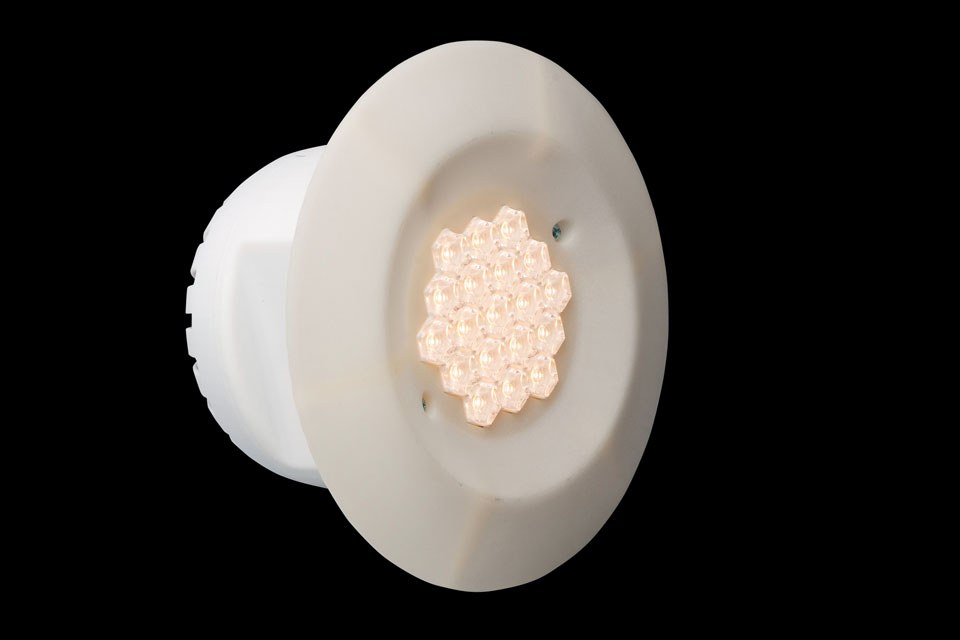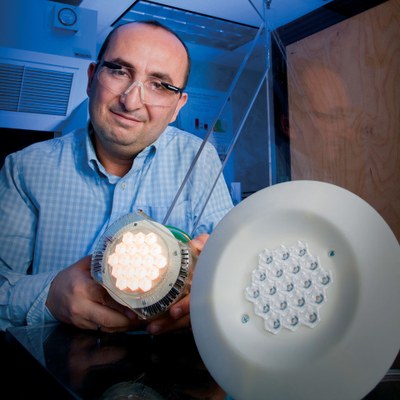GE Scientists Employ Jet Engine Cooling Technology in Prototype LED Bulb
A 1,500-lumen prototype produces as much light as a 100-watt halogen bulb, using 1/3 the energy. GE’s patented “dual cool jets” technology solves thermal challenges, enables lamp design that is half the size and weight of a 600-lumen LED downlight available today.
Scientists from GE Global Research, the technology development arm for the General Electric Company (NYSE: GE), GE Lighting, and the University of Maryland—as part of a two-year solid-state lighting program with the U.S. Department of Energy—have announced the successful demonstration of a 1,500-lumen LED bulb (a standard 100-watt halogen PAR38 bulb produces 1,500 lumens) that addresses key barriers to more widespread adoption of LED bulbs for general lighting.
The prototype provides a snapshot of the future: “The scientists and technology leaders involved in this collaboration are dissolving some major barriers to the commercialization of general lighting LED bulbs,” says John Strainic, global product general manager for GE Lighting. “We’re taking swings at issues such as higher light output options, thermal management, and bulb size and weight. This kicks open the door to the solid-state age that is upon us.”
This LED technology achievement was announced today during a future of lighting symposium that GE hosted at its Global Research headquarters in Niskayuna, NY.
As part of the DOE project, GE and the research team of Professors Bongtae Han and Avram Bar-Cohen at the University of Maryland's A. James Clark School of Engineering have developed and demonstrated novel cooling technologies that effectively manage the heat and promote lower system costs by reducing the number of LED chips required, when compared to conventional cooling technologies.
Mehmet Arik, a mechanical engineer at GE Global Research and principal investigator on the LED project, says, “This is a revolutionary cooling technology with great promise. It has the potential to help us take LED lighting performance and efficiency to new heights. Through further research and improvements, we may be able to increase performance without compromising the efficiency or lifetime of an LED bulb.”
Aviation and Energy roots:
GE’s cooling solution is based on technology the company now uses in its Aviation and Energy businesses. GE Global Research has a world-class team of fluidics experts who specialize in technologies that manage flow. They are developing innovative ways to control airflow and combustion to dramatically reduce the amount of pressure losses and loading characteristics in aircraft engines and power generation in gas and wind turbines.
Arik adds, “Just one floor down in the same research building, I have colleagues using our dual cool jets technology to improve both the power and efficiency of GE’s jet engines and power generation turbines. With wind turbines, for example, we’re manipulating airflow to increase wind energy production. With LEDs, we’re using dual cool jets to improve the heat transfer rate and reduce the number of chips in the lamp.”
How GE’s dual cool jets technology works:
GE dual cool jets are very small micro-fluidic bellows type devices that provide high-velocity jets of air, which impinge on the LED heat sink. These jets of air increase the heat transfer rate to more than ten times that of natural convection. The improved cooling enables LED operation at high drive currents without losses in efficiency or lifetime. For a given lumen output, the dual cool jets’ improved thermal management reduces the necessary LED chip count. This, in turn, can dramatically lower the cost of the lamp. In addition to performance and cost advantages, this cooling technology enables reductions in LED lamp size and weight.
GE and the University of Maryland are in the final stages of the DOE project. The organizations are now studying ways to improve the reliability and lifetime of LED lighting systems.
About GE – Appliances & Lighting:
GE – Appliances & Lighting spans the globe as an industry leader in major appliances, lighting, systems and services for commercial, industrial and residential use. Technology innovation and the company's ecomagination(SM) initiative enable GE – Appliances & Lighting to aggressively bring to market products and solutions that help customers meet pressing environmental challenges. General Electric (NYSE: GE), imagination at work, sells products under the Monogram®, Profile™, GE®, Hotpoint®, Reveal® and Energy Smart® consumer brands, and Tetra®, Vio™ and Immersion® commercial brands. For more information, consumers may visit www.ge.com.
About GE Global Research:
GE Global Research is one of the world's most diversified industrial research labs, providing innovative technology for all of GE's businesses. Global Research has been the cornerstone of GE technology for more than 100 years, developing breakthrough innovations in areas such as medical imaging, energy generation technology, jet engines and lighting. GE Global Research is headquartered in Niskayuna, New York and has facilities in Bangalore, India, Shanghai, China and Munich, Germany. Visit GE Global Research at www.ge.com/research.
About the A. James Clark School of Engineering:
The Clark School of Engineering, situated on the rolling, 1,500-acre University of Maryland campus in College Park, Md., just outside Washington, D.C., is one of the premier engineering schools in the U.S., with graduate and undergraduate education programs ranked in or near the Top 20. This year, three faculty members affiliated with the Clark School were inducted into the National Academy of Engineering; the Clark School was ranked 13th in the world by the Institute of Higher Education and Center for World-Class Universities in its Academic Ranking of World Universities; and the Wall Street Journal survey of large employers ranked the Clark School 3rd in the nation as a source of entry-level engineers.
The school, which offers 13 graduate programs and 12 undergraduate programs, including degree and certification programs tailored for working professionals, is home to one of the most vibrant research programs in the country. The Clark School garnered research awards of $171 million in the last year. With emphases in key areas such as energy, nanotechnology and materials, bioengineering, robotics, communications and networking, life cycle and reliability engineering, project management, intelligent transportation systems and aerospace, the Clark School is leading the way toward the next generations of engineering advances.
Through its Maryland Technology Enterprise Institute, the Clark School helps bring such advances to the marketplace, providing incubator, support, and educational services to technology entrepreneurs. Visit the Clark School homepage at www.eng.umd.edu.




